源码地址:https://github.com/springsecuritydemo/microservice-auth-center03
当我们登录失败的时候,SpringSecurity 帮我们跳转到了 /login?error URL,奇怪的是不管是控制台还是网页上都没有打印错误信息。
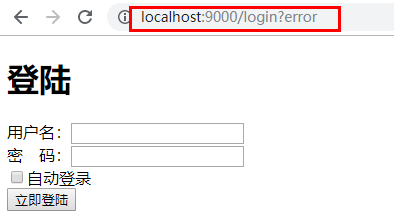
这是因为首先 /login?error 是SpringSecurity 默认的失败 URL,其次如果你不自己处理这个异常,这个异常时不会被处理的。
一、常见异常
我们先来列举下一些 SpringSecurity 中常见的异常:
-
UsernameNotFoundException(用户不存在) -
DisableException(用户已被禁用) -
BadCredentialsException(坏的凭据) -
LockedException(账号锁定) -
CerdentialsExpiredException(证书过期) - ...
以上列出的这些异常都是AuthenticationException的子类,然后我们看 SpringSecurity 是如何处理AuthenticationException异常的。
二、源码分析
SpringSecurity的异常处理是在过滤器中进行的,我们在 AbastrctAuthenticationProcessingFilter 中找到了对 Authentication 的处理:
-
在 doFilter() 中,捕获 AuthenticationException 异常,并交给 unsuccessfulAuthentication() 处理。

-
在
unsuccessfulAuthentication()中,转交给了SimpleUrlAuthenticationFailureHandler类的onAuthencicationFailure()处理。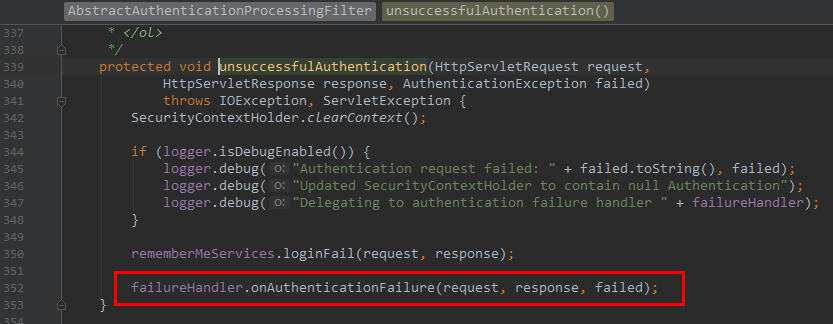
-
在 onAuthenticationFailure() 中,首先判断有没有设置
defaultFailureUrl。a. 如果没有设置,直接返回 401 错误,即
HttpStatus.UNAUTHORIZED的值。
b. 如果设置了,首先执行saveException()方法。然后判断forwardToDestination是否为服务器调整,默认使用重定向即客户端跳转。
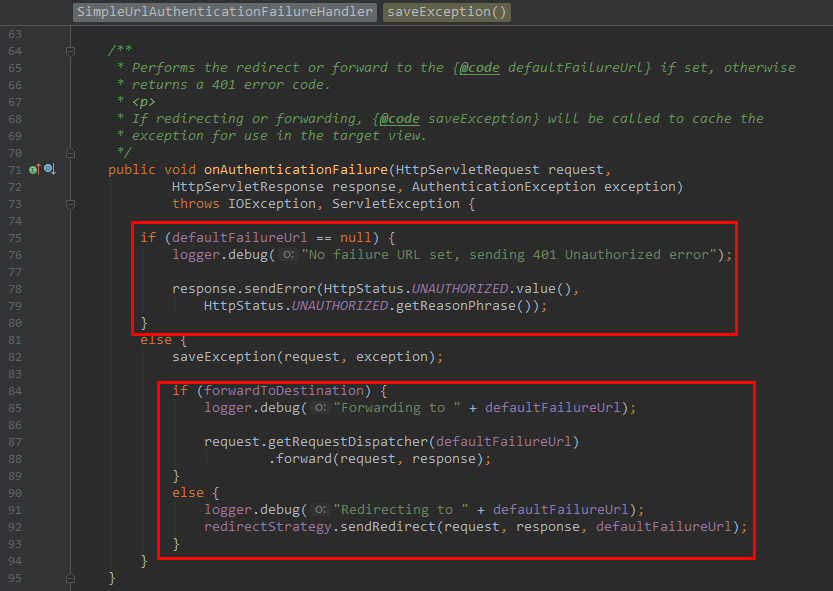
- 在 saveException() 方法中,首先判断
forwardToDestination,如果使用服务器跳转则写入Request,客户端跳转则写入Session。写入名为WebAttributes.AUTHENTICATION_EXCEPTION常量对应值SPRING_SECURITY_LAST_EXCEPTION,值为AuthenticationException对象。
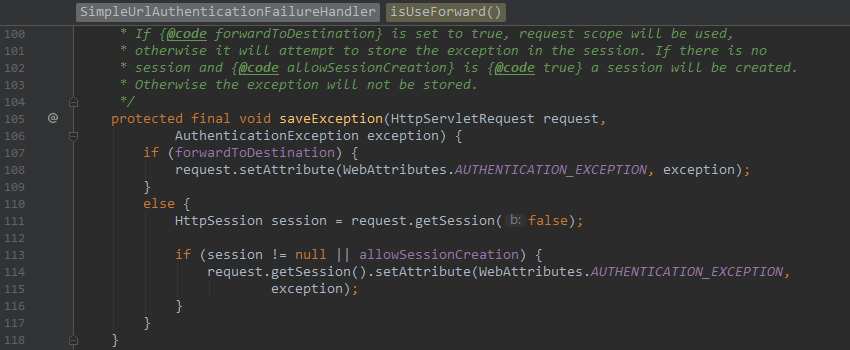
至此 SpringSecurity 完成了异常处理,总结下流程:
–> AbstractAuthenticationProcessingFilter.doFilter()
–> AbstractAuthenticationProcessingFilter.unsuccessfulAuthentication()
–> SimpleUrlAuthenticationFailureHandler.onAuthenticationFailure()
–> SimpleUrlAuthenticationFailureHandler.saveException()
三、处理异常
上面通过源码看着挺复杂,但真正处理起来SpringSecurity为我们提供了方便的方式,我们只需要指定错误的url,然后在该方法中对异常进行处理即可。
- 指定错误url ,在
WebSecurityConfig中添加.failureUrl("/login/error"):
@Override
protected void configure(HttpSecurity http) throws Exception {
http.authorizeRequests()
// 如果有允许匿名的url,填在下面
// .antMatchers().permitAll()
.anyRequest().authenticated()
.and()
// 设置登陆页
.formLogin().loginPage("/login")
// 设置登陆成功url
.defaultSuccessUrl("/").permitAll()
// 设置登录失败url
.failureUrl("/login/error")
// 自定义登陆用户名和密码参数,默认为username和password
// .usernameParameter("username")
// .passwordParameter("password")
.and()
.logout().permitAll()
// 自动登录
.and().rememberMe()
.tokenRepository(persistentTokenRepository())
// 有效时间,单位:s
.tokenValiditySeconds(60)
.userDetailsService(userDetailsService);
// 关闭CSRF跨域
http.csrf().disable();
}
- 在 Controller 中编写
loginError方法完成异常处理操作:
@GetMapping("/login/error")
@ResponseBody
public Result loginError(HttpServletRequest request) {
AuthenticationException authenticationException = (AuthenticationException) request.getSession().getAttribute(WebAttributes.AUTHENTICATION_EXCEPTION);
log.info("authenticationException={}", authenticationException);
Result result = new Result();
result.setCode(201);
if (authenticationException instanceof UsernameNotFoundException || authenticationException instanceof BadCredentialsException) {
result.setMsg("用户名或密码错误");
} else if (authenticationException instanceof DisabledException) {
result.setMsg("用户已被禁用");
} else if (authenticationException instanceof LockedException) {
result.setMsg("账户被锁定");
} else if (authenticationException instanceof AccountExpiredException) {
result.setMsg("账户过期");
} else if (authenticationException instanceof CredentialsExpiredException) {
result.setMsg("证书过期");
} else {
result.setMsg("登录失败");
}
return result;
}
四、运行项目
首先我们修改 CustomUserDetailsService loadUserByUsername() 方法的返回值:

-
输入错误的用户名或密码:
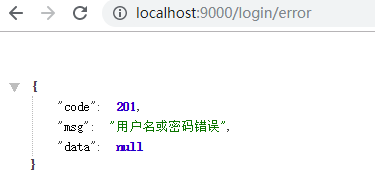
-
修改返回值:enable 为 false

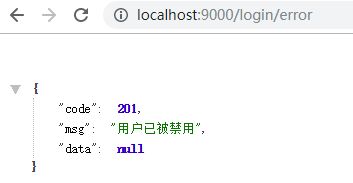
-
修改返回值:accountNonExpired 为 false

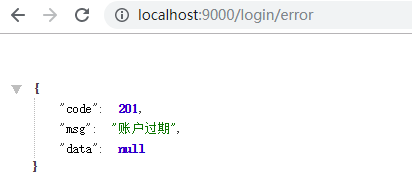
-
修改返回值:credentialsNonExpired 为 false

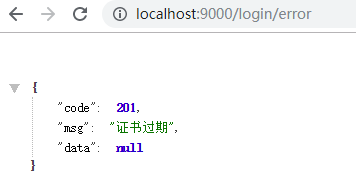
-
修改返回值:accountNonLocked 为 false

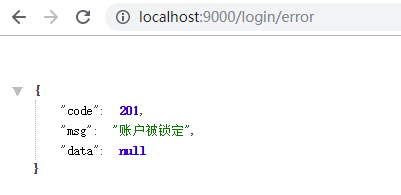
五、存在问题
细心的同学再完成上面功能是会发现,当我们输入的用户名不存在时,不会抛出UserNameNotFoundException,而是抛出 BadCredentialsException这个异常,如果有需要区分 用户名不存在和密码错误的,可参考https://blog.csdn.net/wzl19870309/article/details/70314085。





















 1万+
1万+











 被折叠的 条评论
为什么被折叠?
被折叠的 条评论
为什么被折叠?








